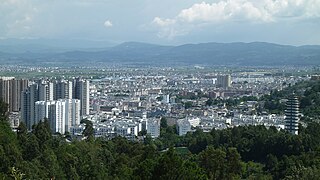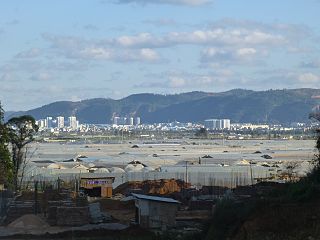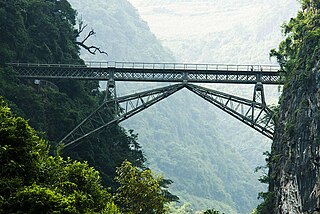
Dali City is the county-level seat of the Dali Bai Autonomous Prefecture in northwestern Yunnan. Dali City is administered through 12 township-level districts, two of which are also commonly referred to as Dali.

Shangrao is a medium-sized prefecture-level city located in the northeast of Jiangxi province, People's Republic of China. The city borders the province of Anhui to the north, the province of Zhejiang to the east, and the province of Fujian to the south. Also, the city's western reaches extend into Poyang Lake. Shangrao had a population of 6,491,088 as of 2020 census whom 1,293,399 lived in the built up area made of Xinzhou and Guangxin districts, Guangfeng District not being conurbated yet. Shangrao itself is at the very western edge of the Wu-speaking areas, while most of its associated counties speak Gan.

Lincang is a prefecture-level city located in the southwest of Yunnan province, People's Republic of China.

Pu'er is a prefecture-level city in southern Yunnan Province, China. The urban administrative center of Pu'er is Simao District, which is also the former name of the prefecture-level city itself. A major downturn in the price of tea in 2007 caused severe economic distress in the area. The price of Pu'er has since recovered and Pu'er tea, a type of dark tea, still contributes much to the income of the area.

Neijiang is a prefecture-level city in the southeast of Sichuan province, People's Republic of China. It is located on the Tuo River, midway between the two major cities of Chengdu and Chongqing, is a transportation and food-processing center. The population of the entire prefecture was 3,140,678 at the 2020 census, and the population of the built-up (metro) area was 1,179,140 in the 2 urban districts of Shizhong and Dongxing.

Guangyuan is a prefecture-level city in Sichuan Province, China, bordering the provinces of Shaanxi to the northeast and Gansu to the northwest. The city has a population of 2,305,657 as of the 2020 census.

Mengzi is a city in the southeast of Yunnan Province, China. Administratively, it is a county-level city and the prefectural capital of the Honghe Hani and Yi Autonomous Prefecture, located about 243 kilometres (151 mi) southeast from Kunming, and 400 kilometres northwest from Hanoi, Vietnam. It is situated in the centre of a fertile valley basin on the Yunnan-Guizhou Plateau 1,310 metres (4,300 ft) above the sea level and was home to about 590,300 inhabitants as of 2021 census. Mengzi was formerly Mengzi County (蒙自县) until October 2010, when it was upgraded to a county-level city. Mengzi is the core area of South Yunnan Central City Cluster, which is officially regarded as the political, economic, cultural, and military centre of South Yunnan.

Baoshan, historically also Yongchang, is a prefecture-level city in western Yunnan Province, People's Republic of China. Baoshan is the second-biggest metropolitan area in western Yunnan after Dali.

Zhaotong is a prefecture-level city located in the northeast corner of Yunnan province, China, bordering the provinces of Guizhou to the south and southeast and Sichuan to the northeast, north, and west.

Qujing is a prefecture-level city in the east of Yunnan province, China, bordering Guizhou province to the east and the Guangxi Zhuang Autonomous Region to the southeast; thus, it was called "Key between Yunnan and Guizhou" (滇黔锁钥) and "Throat of Yunnan" (云南咽喉) in the past. It is part of the Central Yunnan Metropolitan Region plan (滇中城市群规划) in effect for 2016–49. Its administrative population is 6,047,000 according to a 2015 estimate, of whom, 1,408,500 reside in the metro area, which contains Qilin District, Zhanyi District and Malong District. During the 11th National Five-Year Plan period, the government of Qujing planned to develop the city into the "big city at the origin of the Pearl River" (珠江源大城市) in the following decades, including increasing the built-up urban area to past 100 km2 (39 sq mi) and the urban population to surpass 1 million by 2020, the second in Yunnan, after Kunming.

Xinyu, is a prefecture-level city in west-central Jiangxi province, People's Republic of China.

Chuxiong City is a county-level city and the capital of the Chuxiong Yi Autonomous Prefecture, in Central Yunnan Province, China.

Shiping County is a county in the Honghe Hani and Yi Autonomous Prefecture in the southern part of the Yunnan province, China. It is located about 240 km (150 mi) from Kunming, the provincial capital. The county has a population of approximately 280,000 and its area is 3,037 km2 (1,173 sq mi).

Mangshi, former name Luxi (潞西), is a county-level city and the seat of Dehong Dai and Jingpo Autonomous Prefecture, western Yunnan province, China. Mangshi has an area of 2,900.91 km2 (1,120.05 sq mi), with an urban area of 18.66 km2 (7.20 sq mi). Han Chinese, Dai people and Jingpo people are the major ethnic groups. Luxi County was founded in 1949, and became a county-level city in 1996.

Tonghai County is located in Yuxi Prefecture-level City, Yunnan Province, China.

Eshan Yi Autonomous County is located in Yuxi, in the central part of Yunnan Province, China.

Xinping Yi and Dai Autonomous County is an autonomous county located in the central part of Yunnan Province, China. It is the westernmost county-level division of the prefecture-level city of Yuxi.

Heqing County is a county in the Dali Bai Autonomous Prefecture located in the northwest of Yunnan Province, China.

Pingbian Miao Autonomous County is a county located in Honghe Hani and Yi Autonomous Prefecture in the southeast of Yunnan province, China. Its seat is located only 21 kilometres (13 mi) from the border with Lào Cai Province, Vietnam.

Mengla County is a county under the jurisdiction of the Xishuangbanna Dai Autonomous Prefecture, in far southern Yunnan province, China. Meng is a variation of Mueang.



























